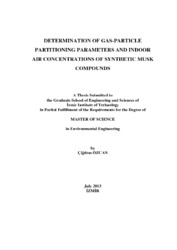Please use this identifier to cite or link to this item:
https://hdl.handle.net/11147/3588Full metadata record
| DC Field | Value | Language |
|---|---|---|
| dc.contributor.advisor | Sofuoğlu, Aysun | - |
| dc.contributor.author | Özcan, Çiğdem | - |
| dc.date.accessioned | 2014-07-22T13:51:53Z | - |
| dc.date.available | 2014-07-22T13:51:53Z | - |
| dc.date.issued | 2013 | - |
| dc.identifier.uri | http://hdl.handle.net/11147/3588 | - |
| dc.description | Thesis (Master)--Izmir Institute of Technology, Environmental Engineering, Izmir, 2013 | en_US |
| dc.description | Includes bibliographical references (leaves: 53-59) | en_US |
| dc.description | Text in English; Abstract: Turkish and English | en_US |
| dc.description | ix, 59 leaves | en_US |
| dc.description.abstract | Gas-particle partitioning of compounds is the key process determining the fate of chemical in the environment. The partitioning process can be modeled depending upon dominancy of being adsorptive or absorptive partitioning and referred with partition coefficient (Kp m3.μg-1). Kp is related to liquid phase vapor pressure of a compound of interest. Due to difficulty related to model parameters, researchers have been developed a parameter called octanol air partition coefficient, KOA which can be directly measured and used to estimate Kp. Synthetic musk compounds (SMCs) are the one group of semi volatile organic compounds which are resistant to degradation, lipophilic and have moderate vapor pressures. They have been widely used in detergents, soaps, cosmetics, perfumes to give nice odorous effect for the product of interest. Most of their chemical properties values based on estimation methods. This study designed to measure octanol-air partition coefficients (KOA) and supercooled liquid vapor pressures (PL) by GC retention time method as a function of temperature to estimate gas-particle partitioning of SMCs. In addition ten indoor air gas and particulate phase samples were collected from a university cafeteria to determine experimental partition coefficient in the indoor air environment. The log KOA and log PL values of synthetic musk compounds were ranged between 6.42 to 8.77 and 0.52 to -4.53, respectively at 25 0C. All of the compounds were detected in the gas phase and the concentrations ranged from 0.27 ng/m3 to 106.8 ng/m3. In the particulate phase only DPMI, ADBI, ATII, MX and MK were detected in the range of 0.06 ng/m3 to 210.5 ng/m3. Although the correlation between the gas-particle partitioning coefficient (KP) and PL was found as weak, KOA was determined as a good descriptor for gas-particle partitioning process. | en_US |
| dc.language.iso | en | en_US |
| dc.publisher | Izmir Institute of Technology | en_US |
| dc.rights | info:eu-repo/semantics/openAccess | en_US |
| dc.subject | Gas-particle partitioning | en_US |
| dc.subject.lcsh | Volatile organic compounds--Environmental aspects | en |
| dc.title | Determination of Gas-Particle Partitioning Parameters and Indoor Air Concentrations of Synthetic Musk Compounds | en_US |
| dc.type | Master Thesis | en_US |
| dc.institutionauthor | Özcan, Çiğdem | - |
| dc.department | Thesis (Master)--İzmir Institute of Technology, Environmental Engineering | en_US |
| dc.relation.publicationcategory | Tez | en_US |
| dc.identifier.wosquality | N/A | - |
| dc.identifier.scopusquality | N/A | - |
| item.openairetype | Master Thesis | - |
| item.cerifentitytype | Publications | - |
| item.grantfulltext | open | - |
| item.fulltext | With Fulltext | - |
| item.openairecristype | http://purl.org/coar/resource_type/c_18cf | - |
| item.languageiso639-1 | en | - |
| Appears in Collections: | Master Degree / Yüksek Lisans Tezleri Sürdürülebilir Yeşil Kampüs Koleksiyonu / Sustainable Green Campus Collection | |
Files in This Item:
| File | Description | Size | Format | |
|---|---|---|---|---|
| 10011343.pdf | MasterThesis | 891.96 kB | Adobe PDF |  View/Open |
CORE Recommender
Page view(s)
252
checked on Apr 7, 2025
Download(s)
82
checked on Apr 7, 2025
Google ScholarTM
Check
Items in GCRIS Repository are protected by copyright, with all rights reserved, unless otherwise indicated.